- AROUND THE SAILING WORLD
- BOAT OF THE YEAR
- Email Newsletters
- America’s Cup
- St. Petersburg
- Caribbean Championship
- Boating Safety
- Ultimate Boating Giveaway


The Supreme Soloists of the Ultimes
- By James Boyd
- January 9, 2024
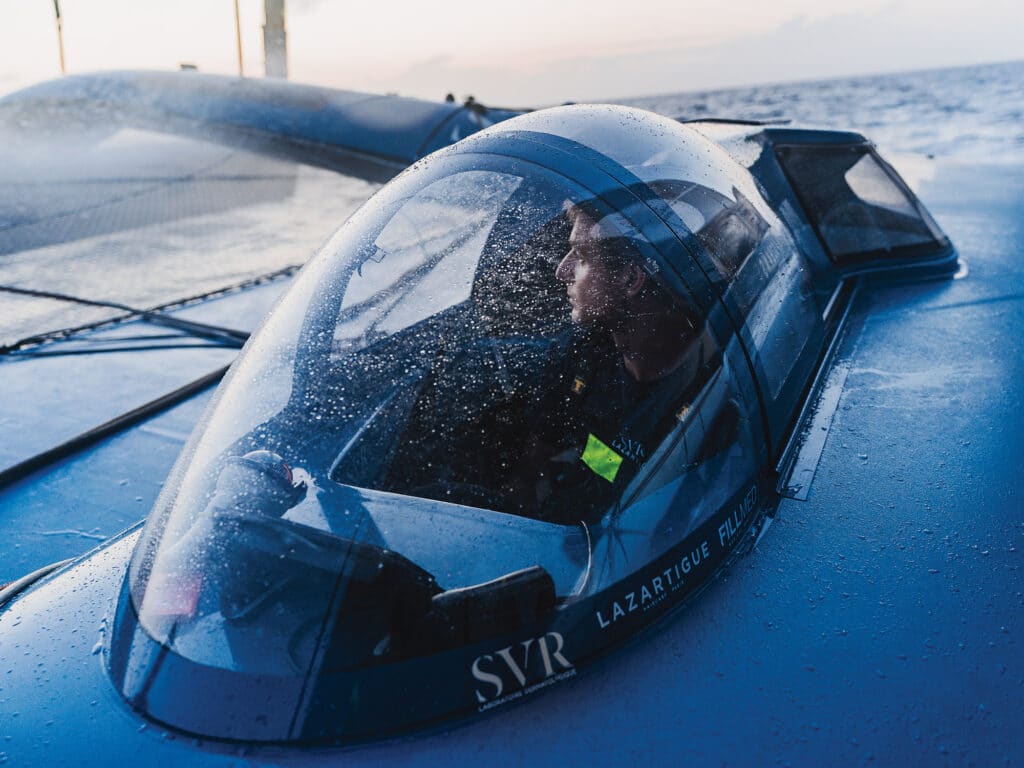
On January 7, ocean racing will take another evolutionary step with the mind-boggling feat of six brave Frenchmen who will set off from Brest in northwest France on board their giant 105-by-75-foot foiling trimarans—around the world, nonstop. Singlehanded. The new event is the Arkea Ultim Challenge-Brest, a sprint marathon that is expected to take 45 days or less at an average of 20 knots.
The present record for a solo lap of the planet stands at 42 days, 16 hours, 40 minutes, 35 seconds, but when this was set in 2018, skipper François Gabart had the luxury of departing with an optimal 10-day forecast (covering the first quarter of his voyage all the way down to the Southern Ocean). Competitors in the Arkea Ultim Challenge-Brest will have to leave on the designated start date and make the best of whatever Mother Nature offers them. However, while Gabart’s MACIF trimaran is going again (in new livery as Anthony Marchand’s Actual Ultim 3 ), it is now one of the older of the six trimarans that will set out. The newest Ultims, which harness the latest offshore foiling technology, are much, much faster.
Two of the biggest names in solo round-the-world record-breaking will be missing from the lineup; Gabart has passed over the helm of his Ultim to “the next generation” in Tom Laperche. Francis Joyon, who demolished the record for the solo lap on two occasions, bringing it down from 125 days to 72 days in 2005 and from 71 days to 57 days four years later, is now 67. While all six starting skippers are highly experienced, they range in age from 55-year-old Thomas Coville, skipper of Sodebo Ultim 3 , to 26-year-old Laperche.
Coville is the race titan. When it comes to racing large trimarans around the world singlehanded, his experience is unprecedented. He’s been attempting circumnavigation records on large trimarans since 1997 and as a skipper since 2008. On his fifth attempt in 2016, he finally set a new record only for it to be broken a year later by Gabart. He also has raced in the America’s Cup and the Volvo Ocean Race (winning it with Franck Cammas on Groupama in 2011-12) and was twice part of crews claiming the Jules Verne Trophy (fully crewed, nonstop around-the-world record). He has completed circumnavigations eight times—four times solo and six times on trimarans.
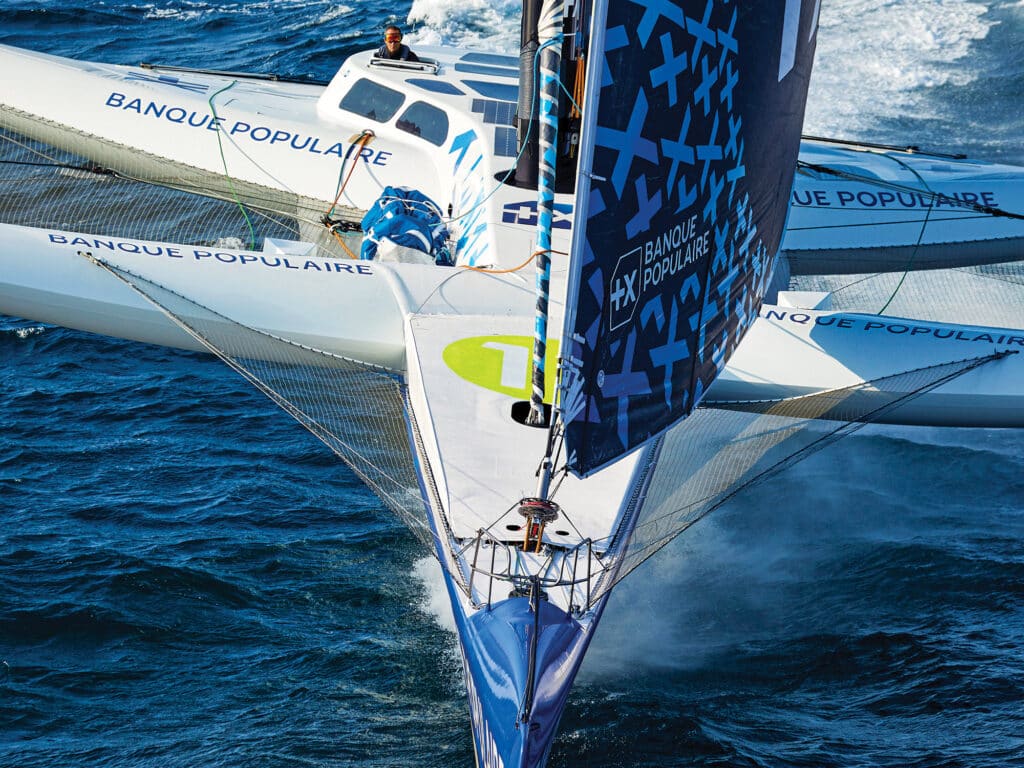
The most hotly tipped skippers, however, are Armel le Cléac’h, 46, on Maxi Banque Populaire XI, and Charles Caudrelier, 49, on Maxi Edmond de Rothschild . While Caudrelier is best known for being a two-time Volvo Ocean Race winner (with Groupama , then as skipper of Dongfeng Race Team in 2017-18), both cut their teeth solo racing in the French one-design Figaro circuit. But when it comes to solo offshore credentials, Le Cléac’h knocks it out of the park. He’s won La Solitaire three times, most recently in 2020, and crucially for the upcoming Arkea Ultim Challenge-Brest has also raced in three Vendée Globe races, finishing on the podium in all and winning in 2016-17.
Le Cléac’h’s trimaran was launched in 2021 as a replacement for his previous Banque Populaire-backed Ultim, which broke up terminally in the 2018 Route du Rhum. Maxi Edmond de Rothschild is unique in the race for being designed by Guillaume Verdier, while the rest are from VPLP (although in every case, the team itself offers substantial input). While Caudrelier has won most Ultim silverware in recent seasons, including the singlehanded Route du Rhum trans-Atlantic race in 2022, Le Cléac’h ended his run by winning this fall’s Transat Jacques Vabre race between Le Havre in northern France and the French Caribbean island of Martinique.
Tom Laperche has taken over as skipper of Francois Gabart’s SVR-Lazartigue for solo races. This is Gabart’s second Ultim trimaran and is considered the most advanced of the six. Laperche won La Solitaire du Figaro in 2022 and has raced with Gabart on the Ultim ever since the boat was launched. He gained his round-the-world experience on the IMOCA Holcim in The Ocean Race.
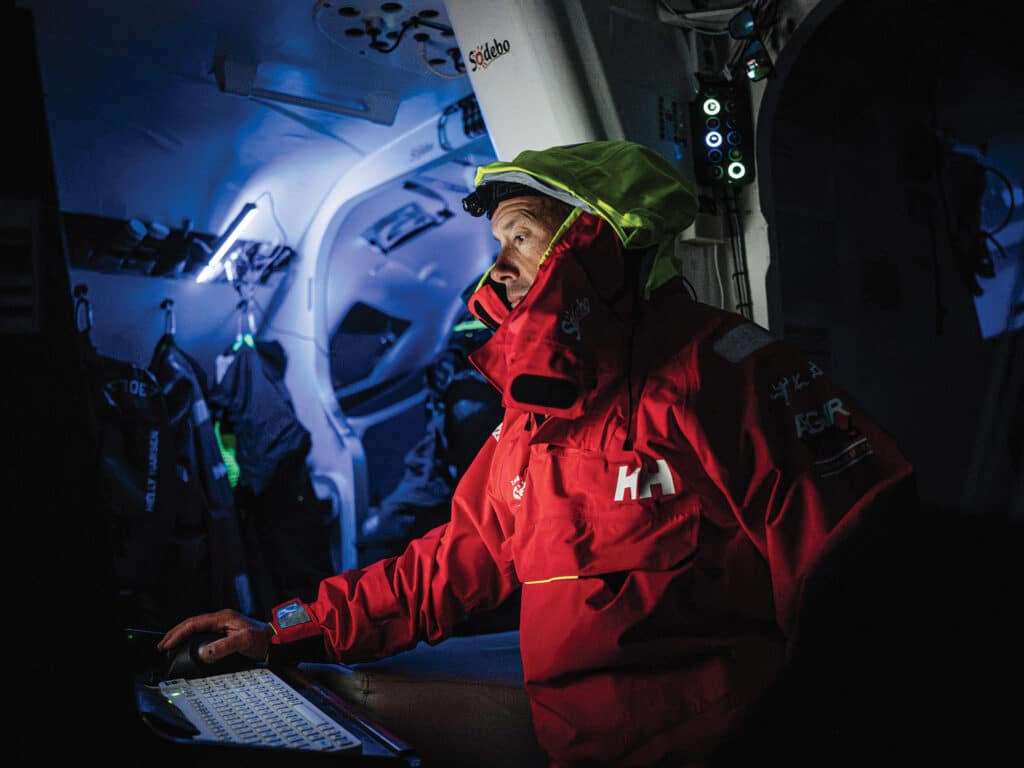
Also inheriting his Ultim campaign is Anthony Marchand, who took over the helm of Actual Ultim 3 from Yves le Blevec in January. Launched in 2015, Actual Ultim 3 is Gabart’s former MACIF trimaran, which is the present holder of the solo round-the-world record. Marchand, 38, sets off with vast experience on ORMA 60 trimarans, in the Figaro class, the Volvo Ocean Race (competing in 2015-16 on MAPFRE ) and in the IMOCA.
Fundamentally, the rule limits length to 32 meters and width to 23 meters, and the complex foil configuration on all six Ultims is fairly similar.
Éric Péron, 42, is the race’s last-minute entry, and as a newcomer to the Ultim class, he will likely back marker. Péron has a strong background in the Figaro and Ocean 50 trimaran classes, and his trimaran Adagio was previously Sodebo Ultim , on which Coville set both his solo round-the-world and west-to-east trans-Atlantic records.
While there is an Ultim 32/23 rule, the design parameters of these incredible machines is a work in progress. Fundamentally, the rule limits length to 32 meters and width to 23 meters. The complex foil configuration on all six Ultims is fairly similar. Each of the boats has six appendages, including the giant, retracting rake-adjustable J-foils (of varying shapes) in the floats. The latest-generation foils have grown larger, enabling the trimarans to fly both downwind and upwind in less wind. Among the three front-runners, the most recent edition of the Transat Jacques Vabre demonstrated that SVR-Lazartigue has the lowest take-off speed, while Maxi Banque Populaire XI ’s foils work best in waves. Maxi Edmond de Rothschild lies somewhere between these two positions.
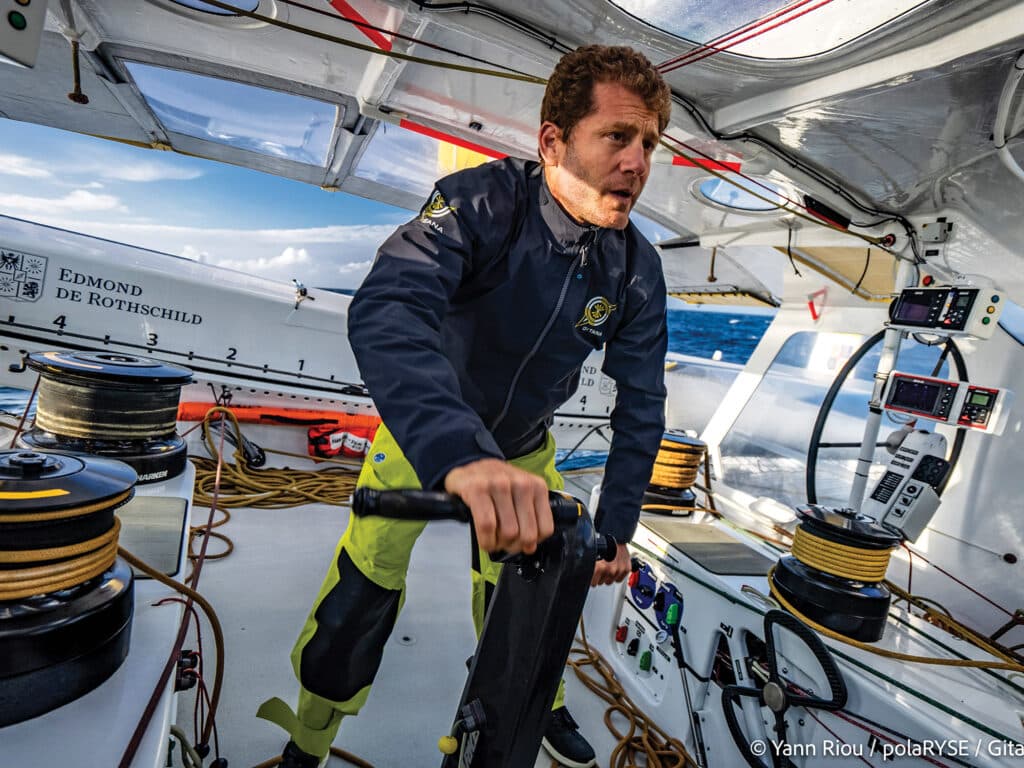
Unique to the Ultims is the T-foil pioneered by Caudrelier’s team on their MOD70 (now Giovanni Soldini’s Maserati ). Located in the center hull, this is effectively a daggerboard with a trim tab (to aid pointing ability upwind) and an elevator. This foil is used in a similar fashion to how AC50 catamaran crews negatively raked their windward rudder elevator to produce downforce, sucking the weather hull down. When a gust hits an Ultim, the crew can drop the traveler, but a more energy efficient response is to increase pitch on the T-foil’s elevator to create additional downforce. Then there are three rudders (one on each hull), each with an elevator. The rudders in the floats can be raised (typically the windward one) to reduce drag.
Aside from the significant developments to the foils, especially to reduce cavitation at high speed, teams have been focusing on improving aerodynamic efficiency. The Ultims now have low-drag vinyl fairings for the aft side of their crossbeams, and on some boats, the deck itself forms an endplate for the foot of sails. Living quarters have improved dramatically and, like modern IMOCAs, are becoming increasingly enclosed. The most extreme among them is Sodebo Ultim 3 , where the front of Coville’s “bridge” is forward of the mast step.
Autopilots have transcended beyond being able to steer to course, apparent wind angle or even true wind angle. Depending on the point of sail, the pilot will now automatically head up or bear away when a gust hits.
The rigs are the same as those that have been fitted to French multihulls for the past 30 years—a rotating wing mast with each shroud terminating in a giant hydraulic ram, permitting the rig (and its center of effort) to be canted to weather. This reduces the downward force on the leeward bow, which can cause multihulls to pitchpole. Whether this is still required is a moot point because today’s foils effectively keep the leeward bow from immersing.
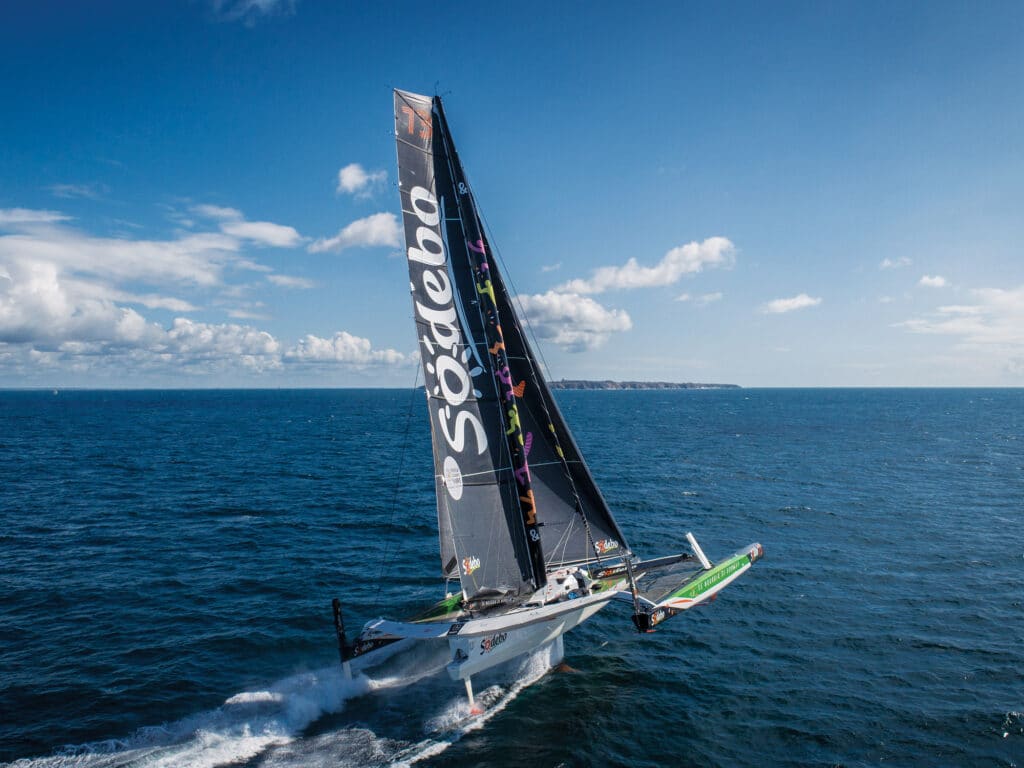
Due to the sheer physics of an Ultim, aided by the canting rig and the mast being stepped so far aft, the risk of capsize is almost nonexistent, Caudrelier says: “The Ultims are the safest multihulls because they fly, because they are big, but also because we have made huge improvements to the pilots with safety functions, and also we have a nice automatic system to ease the sails. It is quite safe. I don’t worry too much about capsizing, but I have in the back of my mind that it can happen.”
Thanks to teams working with such companies as B&G and Pixel sur Mer, Ultim autopilots have transcended beyond being able to steer to course, apparent wind angle or even true wind angle. Depending on the point of sail, the pilot (using what’s referred to as its “safety overlay”) will now automatically head up or bear away when a gust hits, which it can detect by the wind instruments or an inclinometer. In extreme circumstances, they have systems to dump the sheets, although these too seem to be near-redundant.
An interesting point of dispute between the Ultim teams is how much automation should be permitted. Caudrelier’s team is pro automation, while other teams are less so. As a result, the autopilot can perform these functions but cannot, for example, adjust the boat’s flying mechanism, to automatically set ride height, pitch, etc.
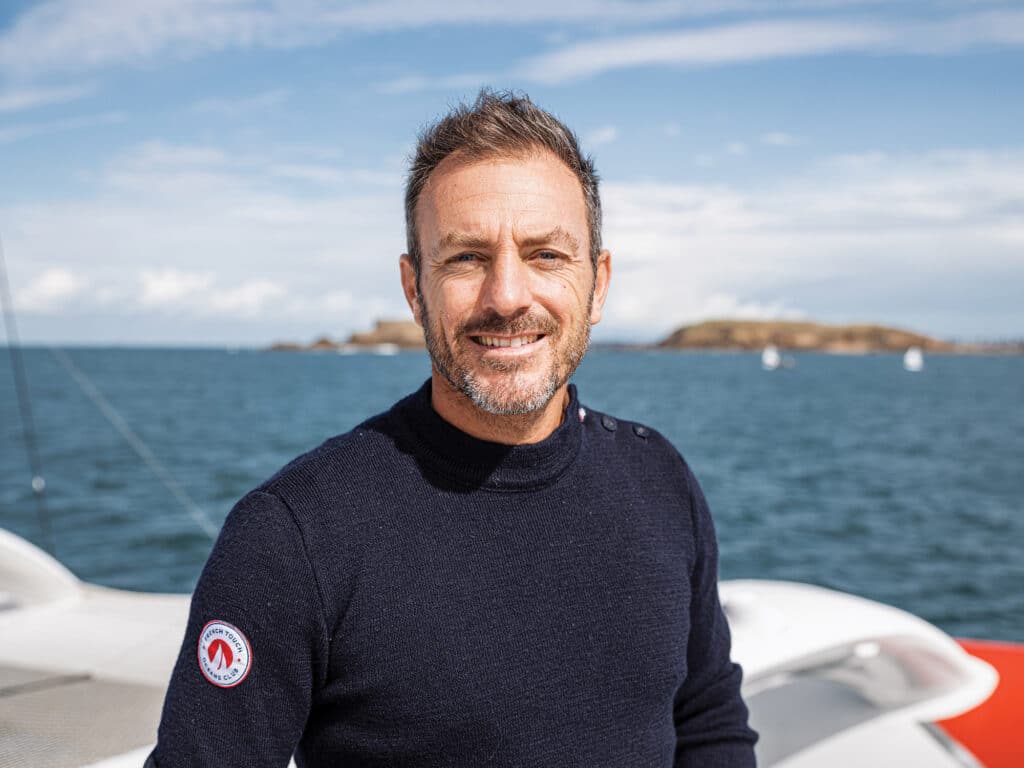
If capsize is less of a concern, then the skipper’s biggest worries are technical failures on their giant boats, as well as collisions. They have tried to overcome the former through sheer time at sea, testing and failing to improve reliability. Le Cléac’h, for example, says that in the past year, he has sailed Maxi Banque Populaire XI some 20,000 miles, or half a circumnavigation. This has been solo and crewed, in a mix of races, private sea trials and the Ultim fleet training en masse. To avoid collisions, the Ultims have all available kit from radar to AIS alarms to the latest tech such as SEA.AI, which uses a masthead-mounted camera array to see objects—floating or semisubmerged—in the water ahead of the boat. These are compared in real time with the SEA.AI’s huge and ever-growing database of objects to identify them as threats.
In the recent Transat Jacques Vabre, Maxi Edmond de Rothschild suffered rudder issues soon after the start (later found to be a delaminating starboard rudder) and then damage to its port J-foil, but it still finished the race. It seems, therefore, very likely that this level of attrition can be expected in the Arkea Ultim Challenge-Brest. Caudrelier says that this proved to be a wake-up call for his team as well as valuable practice for how to deal with midrace technical issues. For example, the J-foil damage occurred after a small impact. “But while we were sailing, the damage increased,” he says. Perhaps it would have been faster in the long term to stop, fix the issue, and then continue, he muses. For bigger issues, race’s sailing instructions permit skippers to pitstop where their teams can join them to effect repairs, but in this case, they are obliged to spend a minimum of 24 hours in port as a penalty.
To help reduce risks, OC Sport Pen Duick, the race’s organizers, are imposing a movable virtual ice barrier as we have seen in other round-the-world races. Competitors must stay north of this, regardless of whether it drives them into high pressure or storms. Interestingly, they are also imposing exclusion zones around known breeding grounds for whales (yet to be defined at the time of writing).
The Arkea Ultim Challenge-Brest may be a solo race, but each campaign is genuinely a team affair. Ultim teams today are giant, some the scale of America’s Cup teams two or three decades ago, with their own in-house designers, engineers, hydro and aerodynamic specialists, and electronic and hydraulic experts. In the event of a technical issue during the race, skippers can now get immediate support using reliable satellite communications. The most consistent remote support each skipper gets is with their routing. In the Ultim class, shore-based routing is permitted. Le Cleac’h, for example, is using Dutch legend Marcel van Triest and French skipper/navigator Nicolas Lunven to provide round-the-clock routing assistance.
Ultims are fast—50 knots is very possible—but skippers are less interested in top speed and entirely focused on maintaining high averages of 30 to 35 knots. They don’t need much wind to achieve such a pace, however. An Ultim’s optimal conditions are broad-reaching in 20 to 25 knots. Any more wind than that, and the sea state gets too large to foil safely. Even in optimal wind conditions, skippers must back off if sea state and wave direction is not ideal. Understanding this is vital to the routing process.
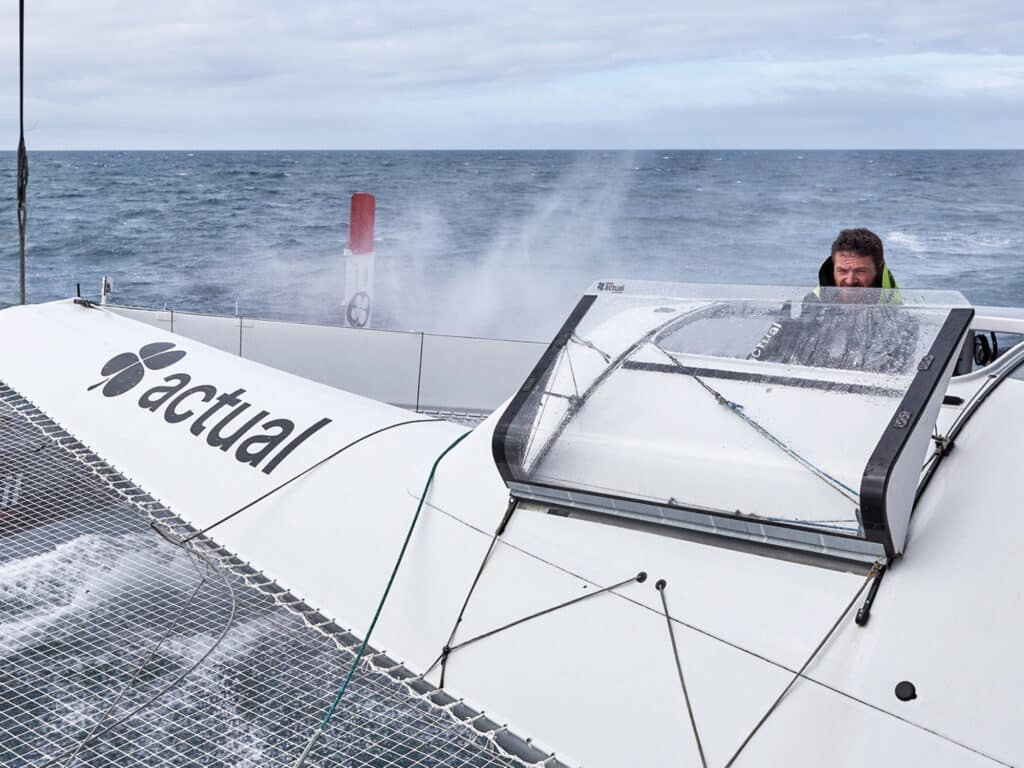
The Ultims are potentially so fast that their routing team can go a long way in ensuring that they stay in optimal conditions. For example, in the Southern Ocean, if they can get into the optimal reaching conditions in flat water ahead of a front, they can potentially ride this for days. But the biggest limitation is the solo skipper. The Ultims typically carry a mainsail and four headsails, including two gennakers and a permanently hoisted J2, all set on furlers. Tacking and jibing requires the sails to be released and sheeted in, the mast to be canted and tacked, and foils and rudders to be raised and lowered. It’s a process that typically takes 20 to 30 minutes. Le Cleac’h says that the most time-consuming sail change is going from the J0 to the J1 because the sails are heavy (around 120 kg), and this can take up to an hour. Factoring all this into the routing is vital because the skipper on his own can do only so much.
“If reaching 95 percent of the boat’s potential requires making three jibes and four tacks and to change two sails, it will be difficult to do that if you are tired,” Le Cleac’h says. His routers offer him three options—from the one offering optimal performance to the easiest for him to achieve—which can be decided based on his energy level and capabilities.
One positive for the skippers is that the required endurance is comparably short compared with a Vendée Globe effort, but still, so much remains unknown as they embark on this extreme test of man and machine.
“It is a bit like the first Vendée Globe,” Caudrelier says. “It is not quite the same because we know where we are going, but it is the first one, so it is a bit of an adventure. Usually you push to the maximum constantly, but for me, this is the first time I can’t do that. We will have to find the good balance between good performance and safety of the boat. That is an interesting exercise.”
- More: Arkea Ultim Challenge Brest , Print January 2024 , Racing , Sailboat Racing
- More Racing
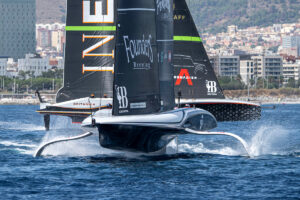
A Dynamic and Proving Day 6 of Louis Vuitton Cup
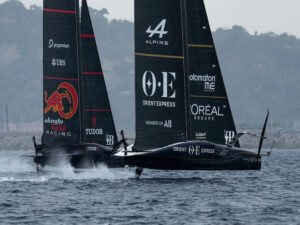
America’s Cup Match Racing at High Speed
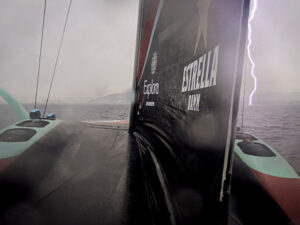
Alinghi Red Bull Racing Bags First Louis Vuitton Cup Point on Electric Day in Barcelona

Barcelona Breeze Increase Spikes Intensity
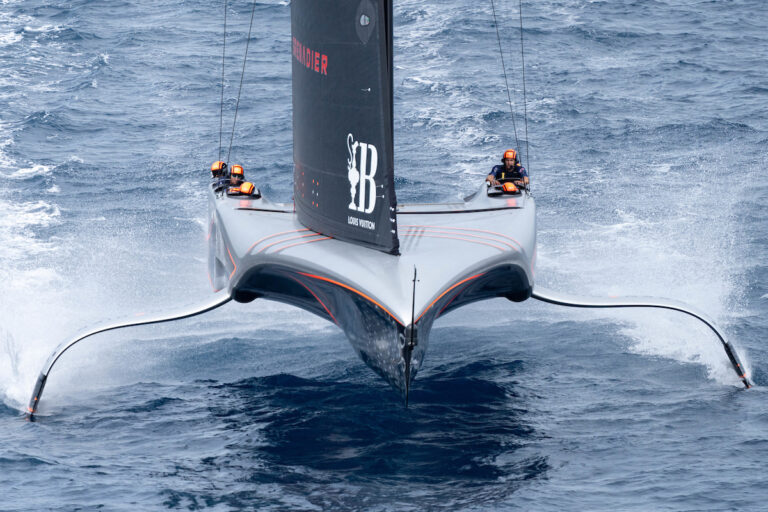
Luna Rossa Dominant on Busy Day in Barcelona
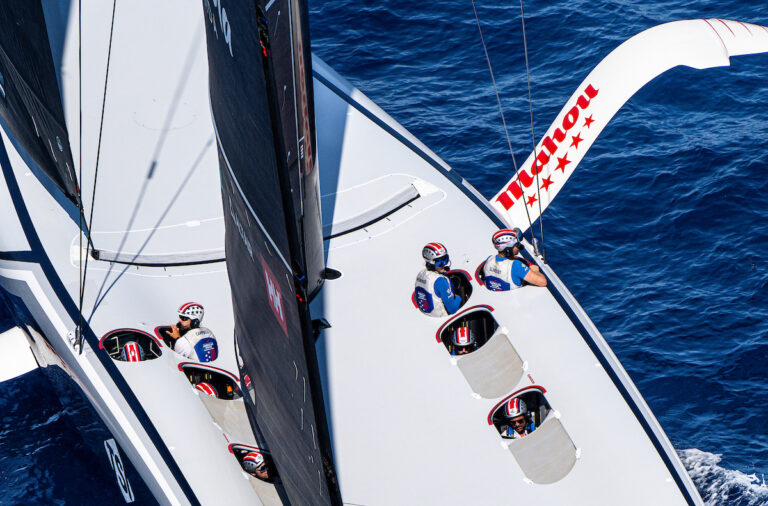
One and Done on Drifter Day of Cup Challenger Series
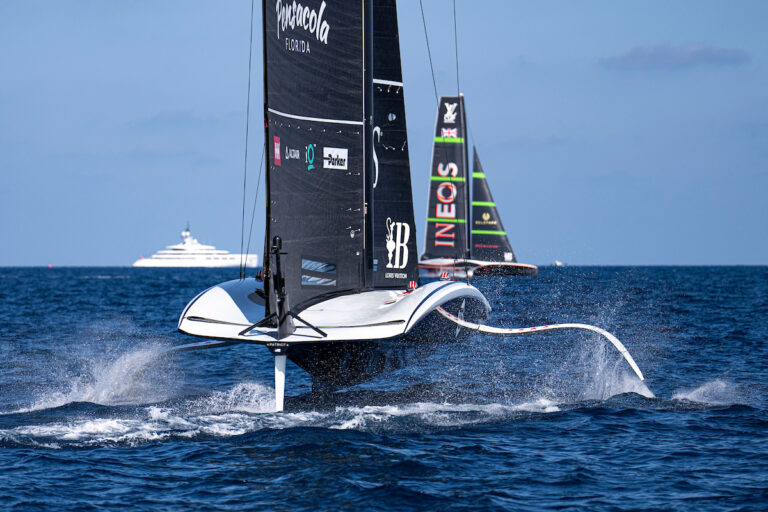
Shocks and Drops At Louis Vuitton Cup Start

- Digital Edition
- Customer Service
- Privacy Policy
- Terms of Use
- Cruising World
- Sailing World
- Salt Water Sportsman
- Sport Fishing
- Wakeboarding
- About the SA Forum
- Join the Forum
- Terms of Use
- Privacy Policy
- View All Listings
- Submit a Photo
- Submit an Article
- Contact the Site Administrator
- Contact the editor

Trophée Jules Verne – Day 7 – Sodebo again on record speed
You Might Also Like

no superyacht for you

stop sailing your boat!
After 19 years in publication, Sailing Anarchy has remained true to its roots as a community oriented, edgy sailing publisher. We have long been, and will continue to be, the leader in providing inside stories, great reports from around the globe, along with the informative, snarky, profane coverage that you have come to expect. Others come and go, dilly dally with bullshit, while we remain Anarchists to the core.

Copyright 2010-2022 Sailing Anarchy, Inc.

The global authority in superyachting
- NEWSLETTERS
- Yachts Home
- The Superyacht Directory
- Yacht Reports
- Brokerage News
- The largest yachts in the world
- The Register
- Yacht Advice
- Yacht Design
- 12m to 24m yachts
- Monaco Yacht Show
- Builder Directory
- Designer Directory
- Interior Design Directory
- Naval Architect Directory
- Yachts for sale home
- Motor yachts
- Sailing yachts
- Explorer yachts
- Classic yachts
- Sale Broker Directory
- Charter Home
- Yachts for Charter
- Charter Destinations
- Charter Broker Directory
- Destinations Home
- Mediterranean
- South Pacific
- Rest of the World
- Boat Life Home
- Owners' Experiences
- Conservation and Philanthropy
- Interiors Suppliers
- Owners' Club
- Captains' Club
- BOAT Showcase
- Boat Presents
- Events Home
- World Superyacht Awards
- Superyacht Design Festival
- Design and Innovation Awards
- Young Designer of the Year Award
- Artistry and Craft Awards
- Explorer Yachts Summit
- Ocean Talks
- The Ocean Awards
- BOAT Connect
- Between the bays
- Golf Invitational
- BOATPro Home
- Superyacht Insight
- Global Order Book
- Premium Content
- Product Features
- Testimonials
- Pricing Plan
- Tenders & Equipment
Video: Sodebo Ultim smashes round-the-world solo sailing record
The 31 metre trimaran Sodebo _ Ultim_ has smashed the record for a single-handed circumnavigation with French sailor Thomas Coville at the helm.
Sodebo Ultim arrived into Brest on December 26 to complete the voyage in 49 days, 3 hours, 7 minutes and 38 seconds, shaving more than eight days off Francis Joyon’s record, which had stood for eight years.
This incredible achievement required Coville to sail across more than 28,000 nautical miles of open ocean on the bare minimum of sleep. Speaking after his arrival, the 48-year-old told Le Parisien : “Mentally I had my highs and my lows but I knew where I wanted to get to. Physically I could not have gone much further.”
Launched by Multiplast in 2001 as Geronimo , Sodebo Ultim is a former Jules Verne record holder. She was refitted in 2013 in collaboration with VPLP Design and now sports a full set of 3DI and NPL sails by North, which gave Coville a wide range of options for dealing with the varied conditions that he faced on his solo circumnavigation.
Sail designer Gautier Sergent worked in collaboration with sail coordinator, Loic Le Mignon and North Sails expert, Quentin Ponroy to design this flexible set-up.
Coville had made five previous attempts before breaking the record, and his 49-day solo circumnavigation now ranks as the fifth fastest round-the-world voyage by any sailing boat.
“Sailing these boats is tough, they are unforgiving,” he added. “If you lose your concentration for two minutes, the boat will take over, and you risk breaking equipment in what quickly spirals into life-threatening situations. You can not back off and 49 days of intense sailing is a long time to maintain your mental focus and physical strength.”
Sign up to BOAT Briefing email
Latest news, brokerage headlines and yacht exclusives, every weekday
By signing up for BOAT newsletters, you agree to our Terms of Use and our Privacy Policy .
More about this yacht
More stories, most popular, from our partners, sponsored listings.

VIDEO: Tour the Ultime Sodebo
Published on November 1st, 2019 by Editor -->
Onboard tour of Thomas Coville’s giant Ultime trimaran, Sodebo, which measures 104 feet long by 75 feet wide. Video published Nov 1, 2019.

Tags: Sodebo , Thomas Coville , Ultim Class
Related Posts

First to foil Giant multihull around world →
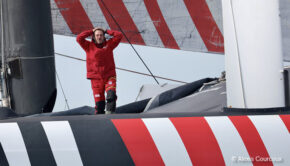
Ultim Challenge done with final finish →
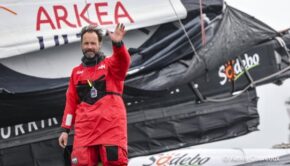
Coville finishes second in Arkea Ultim Challenge →

Caudrelier wins Arkea Ultim Challenge →
© 2024 Scuttlebutt Sailing News. Inbox Communications, Inc. All Rights Reserved. made by VSSL Agency .
- Privacy Statement
- Advertise With Us
Get Your Sailing News Fix!
Your download by email.
- Your Name...
- Your Email... *
- Phone This field is for validation purposes and should be left unchanged.


Sodebo Ultim 3 arrives in home port La Trinité-sur-Mer

The first images of the Trimaran Sodebo Ultim 3 in the port of La Trinité-sur-Mer in Morbihan in Brittany its home port.
The 32m long by 23m wide trimaran was launched at Vannes Multiplast Yard in Morbihan two weeks ago.
Incredibly, Thomas Coville’s new Trimaran is flying from the front, not the rear. The Cockpit is at the front of the Sailboat, in front of the mast.
TV Quiberon 24/7
Sodebo Ultim 3 left the site at Vannes, France, after 18 months of construction in the Multiplast hanger.
Related Post:
Thomas Coville FRA presented his brand-new Trimaran ‘Sodebo 3’
2019 Mirabaud Sailing Video Award entry is open
Rolex fastnet race's pantheon of offshore race boats.


Log in or Sign up
You are using an out of date browser. It may not display this or other websites correctly. You should upgrade or use an alternative browser .
Sodebo Ultim 3 Foiling Trimaran
Discussion in ' Multihulls ' started by Doug Lord , Jan 1, 2019 .
Doug Lord Flight Ready
Actualités - Sodebo Ultim' 3 | Sodebo https://www.sodebo.com/actus/voile/sodebo-ultim-3/ ---------------------- If the renders on the website are accurate this boat is not using a lifting foil on the daggerboard or an uptip foil on each ama. In fact the foils ,as drawn, appear very much dated. However, the renders on Gitana were not accurate until almost the launch. So I bet the foil shapes will change and I believe they'll use a daggerboard lifting foil as well as uptip ama foils-we'll see. Picture by Fred Morin, Team Sodebo:
Sodebo in French:
Heads Up!!! from Tip & Shaft Newsletter today: . Thomas Coville’s new Ultim trimaran, Sodebo, will come out of the Multiplast yard in Vannes on Saturday at 11:30 am. Vid starts at 15:50 in--boat at 37 min in.. -- large uptip ama foils in, no sign of daggerboard foil --renders at end of vid show no main foil, but neither did Gitana renders.. Sodebo may be going with no main foil? -- cockpit in front of the mast ======================================= This quote may indicate that Sodebo will use a mainfoil: From the latest Yacht Racing Forum: • Renaud Bañuls, Bañulsdesign, designing a new foiling Sodebo for Thomas Coville, and a number of foiling craft for weekend sailors: “After achieving foiling, the next big step is creating dynamic righting moment.” Unless they settle for differential rudder flaps to develop extra RM(lee+center rudder T-foil) using "up flap"(downforce) from the mainfoil is the only way to develop dynamic righting moment. Will be interesting to see........
Dolfiman Senior Member
Really impressive design and building, and the unveiling from the hangar is worthy of the one of a new Airbus or Boeing !
Dolfiman said: ↑ Really impressive design and building, and the unveiling from the hangar is worthy of the one of a new Airbus or Boeing ! Click to expand...
An article on the boat-nothing on the foils in a quick read: Un Trimaran Sodebo Ultim 3 révolutionnaire - Course au Large http://www.courseaularge.com/trimaran-sodebo-ultim-3-revolutionnaire.html
Doug Lord said: ↑ An article on the boat-nothing on the foils in a quick read: Un Trimaran Sodebo Ultim 3 révolutionnaire - Course au Large http://www.courseaularge.com/trimaran-sodebo-ultim-3-revolutionnaire.html Click to expand...
Well, thanks! That goes along with what Martin Fischer and Vincent Prevost said in response to my questions today-the picture is getting clearer..... See their responses here: High Performance MPX Foil/Self-righting Trimaran-The Test Model https://www.boatdesign.net/threads/high-performance-mpx-foil-self-righting-trimaran-the-test-model.36058/page-192 post 2877
From Pressure Drop: Pressure Drop - Coville's New Tri Emerges http://www.pressure-drop.us/forums/content.php?9015-Coville-s-New-Tri-Emerges To draw this boat, Renaud Bañuls has also been working with Vincent Lauriot-Prevost, GSEA Design, Hervé Devaux and Martin Fischer. " To imagine a boat like this one, We Did not want it in the hands of one Knowing goal the result of joined work Where everyone can express Themselves. Who says new boat, Said new methods and why not a design team with people I Had coasted to Their expertise. By setting up this Design team, I Knew He Was going to-have me explain to Several People That I Had the taste in the mouth, music, the picture I Had in mind. The transcription of the act is quite disproportionation . There aren't Many acts That measure 32m long and 23 m wide and 34 high! "
Corley epoxy coated
More on Sodebo (and other Ultim's) : https://www.ultimboat.com/
From Voiles et Voiliers https://voilesetvoiliers.ouest-france.fr thanks to qbf on sa for the machine translation: https://voilesetvoiliers.ouest-fran...ifferent-0cf35612-3dd3-11e9-81df-04eb0a99a092 Sodebo Ultim. One of the architects explains the risk of being fundamentally different MACHINE TRANSLATION In the high-flying design team assembled by Thomas Coville, Renaud was one of the very first to work on the project. At the request of the skipper, the architect looked at the beginning of 2015, and for a year and a half, on this very innovative project. He explains the choices we've chosen. Sails and Sailboats: What was the idea that guided your work, did other boats inspire you? Renaud Bailey: The idea of Thomas (Cotown) was to start from a white sheet and try to be as creative as possible. We were not trying to innovate to innovate but we said: What would we do if we wanted to do something really good even if we had to be fundamentally different? And the basis of the reflection is to seek to have the most efficient sail plan possible and then draw the platform to keep this sail plan super efficient. That's what led us to draw this platform a little bit different. Sails and Sailboats: What was the idea that guided your work, did other boats inspire you? Renaud Bailey: The idea of Thomas (Cotown) was to start from a white sheet and try to be as creative as possible. We were not trying to innovate to innovate but we said: What would we do if we wanted to do something really good even if we had to be fundamentally different? And the basis of the reflection is to seek to have the most efficient sail plan possible and then draw the platform to keep this sail plan super efficient. That's what led us to draw this platform a little bit different. [Renaud Banuls, ici sous la coque centrale du nouveau Sodebo Ultim 3, le jour de la présentation du bateau.] Renaud Bailey, here under the central hull of the new Sodebo Ultim 3, on the day of the presentation of the boat. | LOÏC MADELINE/sails and sailboats Sails and sailboats: so this cockpit in front of the mast is first to have a more efficient mainsail? Renaud Bailey: Yes it allows to have a mainsail that comes to the bridge. We tried to increase the efficiency of the mainsail and all the sails but also to decrease the drag of the platform drastically. Sails and sailboats: This can amount to a percentage, this drag gain? Renaud Bailey: Yes, we're pretty happy, we expect 3% gain which is huge for a platform but we must not forget that there are other factors that are fundamental, where you gain a few points on a platform, with a new generation of foils there are a Llures or you will earn 20 to 25% efficiency! The performance will go to the sailor's ability to lead the boat to 100% of its potential. [Le cockpit très protégé est solidaire de la poutre avant, une architecture radicale qui place le barreur en avant du mât.] The highly protected cockpit is in solidarity with the front beam, a radical architecture that places the helmsman in front of the mast. | LOÏC MADELINE Sails and Sailboats: will these foils be enslaved? Renaud Bailey: Today the Ultim class is without servo and the foils have been designed and drawn to operate without any control. If the class changes and the regulations change, we'll be ready. It was already necessary to put in the chassis the maximum performance How to define Sodebo compared to other existing boats? Renaud Bailey: The difference is in the chassis. We work on the same objectives, Appendices, Vol... There we thought that if we left a blank page, we had to put the maximum performance in the chassis. We're talking about passive speed and active speed. Passive speed is all that will give performance to the boat without asking for action from the sailor. Active speed is what will ask for action to the sailor. The foils for example, it requires the action of the sailor, because they must be mounted, because they have to be adjusted and it takes enormous efforts in view of the size of the foils. We worked on the active speed but we tried to go much further on the passive speed, not only to lower the winches a few centimeters to gain in center of gravity.
Pressure Drop - Sodebo Ultime 3 Launched http://www.pressure-drop.us/forums/content.php?9056-Sodebo-Ultime-3-Launched
- Advertisement:
From UltimBoat https://www.facebook.com/UltimBoat/ : Deliciously weird!
Sodebo and Gitana 17 set off on Jules Verne Record attempt
Sodebo launches new boat (tri) for 2019, thomas coville on sodebo departs on his round the world solo record attempt, thomas coville on sodebo departs on solo multihull round the world attempt, sodebo team buy geronimo maxi trimaran, thomas coville on sodebo challenging cadix - san salvador record, arkea ultim challenge : the race around the world, in solo , ultims are back in 2021, ultims are back, for the dhream cup july 19, brest atlantiques 2019 - ultims.
- No, create an account now.
- Yes, my password is:
- Forgot your password?

Yachting World
- Digital Edition

Coville sets incredible new 49-day solo round the world record – with a blistering average speed of 23 knots
- Elaine Bunting
- December 25, 2016
French solo sailor Thomas Coville has succeeded in his fifth attempt to break the solo round the world record with an incredible time of under 50 days

Solo sailor Thomas Coville has pulverised one of the hardest records in sport: the single-handed round the world record. He took his 105ft trimaran Sodebo Ultim over the finish line off Ushant on Christmas Day to set a new time of 49d 3h 7m, smashing the record set in 2004 by Francis Joyon by an incredible margin of 8d 10h.
This new sub-50 day record is one that exceeded all expectations, including perhaps Coville’s himself. It equates to a mind blowing average speed of 23 knots over the entire 27,325-mile course.
The previous record, set by Francis Joyon record in the maxi catamaran IDEC, had stood for 12 years and had resisted three previous unsuccessful attempts by Coville.

Thomas Coville
Thomas Coville’s long quest to gain this record has been punctuated by disappointment and, on two occasions, the bitterest of defeats. His previous challenges have all ended in retirement through damage and, on two attempts he completed circumnavigations only to miss out on the record by days.
But this time Coville had good fortune to match his skill, and benefited from favourable weather that sped him south through the Atlantic. With one gybe he entered the first Roaring Forties low pressure system and managed to stay ahead of a cold front with the following wind angle and low sea state in which his boat performs best.
Coville had no hesitation in diving south, much further than the Vendée Globe yachts have been allowed to do, in pursuit of the right winds and best VMG. He crossed the Indian Ocean in just 8 days ,12 hours and kept going through the Pacific to Cape Horn in 8 days 18 hours.
To put this in context, compare those times to the fully crewed round the world record times. Crossing the Indian Ocean took Banque Populaire V 8 days 7 hours in 2011 and Spindrift 2 8 days 4 hours in 2015.
Such weather occurs perhaps once a decade – and it has taken Coville all these attempts to find and make use of it.

Thomas Coville breaks the solo round the world record on Sodebo Ultim
He made these speeds despite hugely difficult conditions. Through much of the Indian Ocean, Coville experienced 30-40 knots of wind and 10m seas. “We often sailed under three-reefed mainsail and J3. It’s exhausting,” he said. “Living with it is not easy, because you have to be very focused and available for the boat. You have to be outdoors; there’s a lot to regulate.
“The problem there is that either you have too much canvas, or not enough canvas. It is therefore necessary to accept that, at times, you are sailing underwater. Sodebo is big, but in troughs of 10m waves it’s like a model yacht.”
Guided by his weather router, Jean-Luc Nélias, with whom Coville sailed in the the Volvo Ocean Race winner Groupama IV, and with help through 24 hours a day also from friend and fellow sailor Samantha Davies, Coville picked his way carefully through the south to avoid ice.
He had more favourable winds and a much quicker time back up the Atlantic than Joyon had in 2004, when the route was beset with headwinds. This meant Coville was able to extend the handsome lead of over 5 days he had accumulated at Cape Horn.
Coville communicated with his weather team using Skype instant message, and very rarely by speaking and every day the team would put weather maps, satellite photos, synoptic charts, wave height models, grib files and routeing options on an FTP server for Coville to pick up and download.
Coville’s previous failed attempts took a huge amount out of him psychologically, he has admitted.
On his first attempt in 2008, the same year Joyon set his superb record, the crash box of Coville’s theoretically faster trimaran was damaged in a collision, possibly with ice, and he had to retire.
On a second attempt, he endured some quite hair-raising times, including one occasion in the Southern Ocean when, overcanvassed for a squall, his boat lifted up onto one float and set off blindly on a huge surf. Coville was on the point of retreating to the cabin, the only place he’d be sure to survive a capsize, when the boat sat back down, picked up on another surf, and a piece of the traveller whistled by, decapitating both carbon wheels.
He went on to battle up through the Atlantic, only to finish 2 days outside Joyon’s record.

When he tried again in 2013, he suffered in the Southern Ocean, rounding Cape Horn some 800 miles behind the record time (potentially less than a day-and-a-half in such a yacht) and had no better luck in the Atlantic. Once again, he finished in Brest just days outside the record. He broke down in tears and was inconsolable.
Although not as well known outside France as he deserves to be, Thomas Coville is one of the most experienced and accomplished ocean racers in the world. He has now raced round the world eight times. He has twice won the Jules Verne Trophy for the outright (crewed) round the world record: in 1997 with Olivier de Kersauson on Sport-Elec and again in 2010 as part of Franck Cammas’s crew on Groupama 3.
He was also part of Cammas’s winning crew in the 2012/3 Volvo Ocean Race in Groupama 4. He has also race in the 2000/1 Vendée Globe, finishing 6th.
His trimaran, Sodebo Ultim, was originally Olivier de Kersauson’s trimaran Géronimo, built for an (unsuccessful) attempt by de Kersauson on the crewed round the record.
As Sodebo Ultim, little remains of the original configuration other than the platform itself, as it was completely modified by Coville and designers VPLP. A key feature is the foils the trimaran now sports, which came from the USA 17, Oracle Team USA’s 2010 America’s Cup winner.
Key statistics from the record
Start on 6 November at 13 hours 49 minutes and 52 seconds GMT
Passage of the equator: on 12 November at 07h 04min 54s GMT
Time from Ushant / Equator*: 5d 17h 15m 2s
Passage of Cape of Good Hope: 20 November at 18h 33min 40s GMT
Time from Ushant / Good Hope*: 14 days 4 hours 43 minutes and 48 seconds
Passage of Cape Leeuwin: on 27 November at 16:59 GMT
Time from Ushant / Cape Leeuwin: 21 days 3 hours 9 min and 8s
Indian Ocean Record* (Cape Agulhas /Tasmania): 8d 12h 19m on 29 November at 06:51 GMT
or 23h 47min faster than the previous record set by Francis Joyon in 2007 (9d 12h 6min)
Average speed: 25.16 knots for 5,325 miles
Time from Ushant / Tasmania: 22d 17h 1m 23s – or a lead of 2 days 5 hours 4 mins over the record set by Francis Joyon
Pacific Ocean record* (Tasmania/Cape Horn): 8d 18h 28m 30s or 1 day 19h 58min better than the previous record set by Francis Joyon in 2007 (10d 14h 26min)
Time from Ushant / Cape Horn: 31d 11h 30m 8s – Or a lead of 4 days and 59 mins over Francis Joyon’s record
Record Equator/Equator: 35 days 21 hours 38 min 6 sec – Or 5 days 11 hours 36 minutes better

- AMERICA'S CUP
- CLASSIFIEDS
- NEWSLETTERS
- SUBMIT NEWS

Sodeb'O to tackle new record campaign across the Atlantic

Related Articles
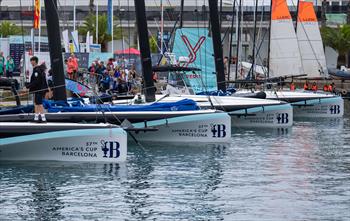

- Visit Our Blog about Russia to know more about Russian sights, history
- Check out our Russian cities and regions guides
- Follow us on Twitter and Facebook to better understand Russia
- Info about getting Russian visa , the main airports , how to rent an apartment
- Our Expert answers your questions about Russia, some tips about sending flowers

Russian regions
- Adygeya republic
- Astrakhan oblast
- Kalmykia republic
- Krasnodar krai
- Rostov oblast
- Volgograd oblast
- Map of Russia
- All cities and regions
- Blog about Russia
- News from Russia
- How to get a visa
- Flights to Russia
- Russian hotels
- Renting apartments
- Russian currency
- FIFA World Cup 2018
- Submit an article
- Flowers to Russia
- Ask our Expert
Astrakhan Oblast, Russia
The capital city of Astrakhan oblast: Astrakhan .
Astrakhan Oblast - Overview
Astrakhan Oblast is a federal subject of Russia, part of the Southern Federal District, situated in the Caspian Lowlands where the Volga River flows into the Caspian Sea. Astrakhan is the capital city of the region.
The population of Astrakhan Oblast is about 989,400 (2022), the area - 49,024 sq. km.
Astrakhan oblast flag
Astrakhan oblast coat of arms.
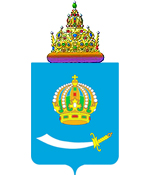
Astrakhan oblast map, Russia
Astrakhan oblast latest news and posts from our blog:.
4 March, 2020 / Astrakhan - one of the oldest cities in southern Russia .
18 May, 2019 / Colorful summer sunset in the Volga River delta .
4 April, 2019 / Cities of Russia at Night - the Views from Space .
11 May, 2017 / Astrakhan Kremlin after the Restoration .
13 December, 2016 / Astrakhan - the view from above .
More posts..
History of Astrakhan Oblast
In ancient times, the territory of the Astrakhan region was crossed by trade routes of the Persians and the Arabs. In the 8th-10th centuries, the territory belonged to the Khazar Khanate. There is a hypothesis that Itil, the capital of the Khazar Khanate, was located on this territory. It was destroyed by Prince Svyatoslav in 965.
Later, Polovtsy settled on this land. In the first half of the 13th century, the Mongol-Tatars came to the area. After them, Tatars of the Astrakhan Khanate and Kazakhs became the main population of the region.
In 1556, during the reign of Ivan the Terrible, the Astrakhan Khanate was annexed to the Russian state and ceased to exist. Astrakhan krai became the southeastern military outpost of Russia. In particular, in 1569, the Turks unsuccessfully besieged the fortress of Astrakhan.
In the 17th century, trade, fishing and salt industries developed in the region. In the middle of the 17th century, the uprising of Stepan Razin took place on the territory of Astrakhan region. In 1722, near the mouth of the Kutum River, a shipyard called the Astrakhan Admiralty was built. In the 1730s-1740s, the processing of silk and cotton began here.
Astrakhan Oblast was created in 1943. The region gained its current borders in 1957.
Steppe landscapes of Astrakhan Oblast
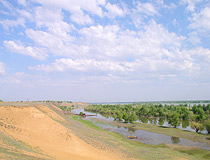
Astrakhan Oblast scenery
Author: Dvornikov Mikhail
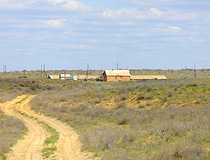
Steppe road in the Astrakhan region
Astrakhan Oblast - Features
Astrakhan Oblast is located in the south-east of the East European Plain within the Caspian Lowlands. It is an area of deserts and semi-deserts. Astrakhan oblast borders on the Volgograd region in the north, the Republic of Kalmykia in the west and Kazakhstan in the east.
It is located on the border between Europe and Asia, the Volga River gives access to five seas. The main cities of the region are Astrakhan (518,700), Akhtubinsk (35,500), Znamensk (25,700), Harabali (17,100).
The climate of Astrakhan Oblast is continental, dry. Winters are with little snow, frequent thaws and unstable snow cover; summers are hot. January is the coldest month, the average temperature is minus 10-20 degrees Celsius. July is the hottest month - the average temperature is plus 35-45 degrees Celsius.
According to the 2010 census, the ethnic composition of the local population is the following: Russians (67.6%), Kazakhs (16.3%) and Tatars (6.6%). Orthodox Christianity is the main religion. However, Muslims also make up a significant group of the population (more than 20%). Historically, this province was a place where Kazakhs and Tatars settled. The largest Kazakh community in Russia lives in the Astrakhan region.
Astrakhan Oblast views

Paved road in Astrakhan Oblast
Author: V.Kildushov

Camels in Astrakhan Oblast
Author: Viktor Grigoriev
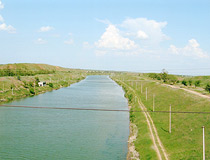
The Volga-Don Shipping Canal in Astrakhan Oblast
Author: Kudanov Pavel
Astrakhan Oblast - Economy
Natural resources of the region include natural gas, oil, salt, gypsum.
The industrial complex of Astrakhan, the economic center of the region, includes shipbuilding, pulp and paper industry, fish processing industry. The leading industries are fuel industry, mechanical engineering, power engineering, food industry. Astrakhan gas condensate field, the largest in the European part of Russia, is located in the area. Astrakhan Gas Processing Plant produces gas for cars, diesel and boiler fuel.
Agricultural lands make up more than 3.4 million hectares - the cultivation of tomatoes, peppers, aubergines, courgettes, cucumbers, carrots, beets, onions, cabbage, watermelons. Rice is traditionally grown along the Volga. The leading branch of livestock is sheep breeding.
The region stretches for over 400 km in the form of a narrow stripe on both sides of the Volga-Akhtubinsk flood-lands. Flooded for a long time, the territory of the delta serves as spawning-ground for such fish as sturgeon, stellate sturgeon, white sturgeon and others.
Astrakhan oblast of Russia photos
Pictures of astrakhan oblast.

Lenin Monument in Astrakhan Oblast
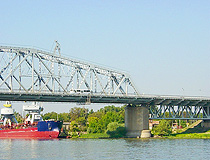
Bridge in Astrakhan Oblast
Author: Anatoliy Martyshkin

Church in Astrakhan Oblast
Limanskiy Khurul - the only active Buddhist temple in Astrakhan Oblast

Limanskiy Khurul in Astrakhan Oblast
Author: Moskaluk Vitaly
The comments of our visitors
- Currently 2.96/5
Rating: 3.0 /5 (205 votes cast)

IMAGES
VIDEO
COMMENTS
http://yachtpals.com Thomas Coville sailing the trimaran sailboat Sodeb'O for a new world sailing record. Sodeb'O sets new sailing record for the most miles ...
The Sodebo Ultim 3 is a 104ft long, 75ft wide trimaran designed to fly above the water and break speed records. Sponsored by Sodebo, the boat will be sailed by Thomas Coville, who aims to reclaim the Jules Verne trophy for the fastest solo circumnavigation.
subscribe for more yachts videos!all videos are copyright of the yacht show!to license any footage email:[email protected]
The Sodebo skipper has just confirmed his choice of boat-yard Multiplast to undertake the transformation necessary to get maxi-trimaran 'Geronimo' ready to c...
Thomas Coville, the most experienced skipper of the Arkea Ultim Challenge-Brest, will sail Sodebo Ultim 3, a 105-foot foiling trimaran, around the world nonstop. The race starts from Brest, France ...
Trophée Jules Verne - Day 7 - Sodebo again on record speed. newsposter December 1, 2020. After 5 days and 9 hours, Thomas Coville FRA and his team passed the equator yesterday, the first milestone of their record attempt. The crossing of the inner-tropical convergence zone slowed down the pace considerably during 24 hours, but now in the ...
Sodebo Ultim 3 is the newest and most innovative Ultime design, with a low boom, forward cockpit and collaborative design team. Thomas Coville aims to break the 40-day barrier for solo sailing ...
The 31 metre trimaran Sodebo Ultim, skippered by Thomas Coville, completed a round-the-world voyage in 49 days, 3 hours, 7 minutes and 38 seconds in 2017. Watch the video and read the details of this incredible achievement and the boat's features.
Onboard tour of Thomas Coville's giant Ultime trimaran, Sodebo, which measures 104 feet long by 75 feet wide. Video published Nov 1, 2019.
The 105 foot Irens - Cabaret trimaran built at Boatspeed had a crew of fourteen on board, including the CEO of the food company Sodebo, plus Boatspeed build staff to thank them for their efforts. With a 22 knot westerly, Sodebo hummed along between 20 - 27 knots, allowing the crew to check systems and wander round offering chocolate chip ...
Two 100ft foiling trimarans, Sodebo and Gitana, started their non-stop, fully crewed circumnavigation off Brest, France, aiming to beat the record of 40 days, 23 hours, 30 minutes and 30 seconds ...
The first images of the Trimaran Sodebo Ultim 3 in the port of La Trinité-sur-Mer in Morbihan in Brittany its home port. The 32m long by 23m wide trimaran was launched at Vannes Multiplast Yard in Morbihan two weeks ago. Incredibly, Thomas Coville's new Trimaran is flying from the front, not the rear.
Sodebo: 18 months of construction. 50,000 hours of study. 110,000 hours of construction. - 32 m long by 23 m wide and 34 m high mast, the surface of 4 tennis courts ... - 65 tons of compression in the mast foot ball. - 17 tons of tension in the mainsheet. - Nearly 700 m² of downwind.
Sodebo was launched as a foiler already back in 2017.Now with a new foiling setup, like a new central dagger, a T foil with flaps we can see on the videos above. Also they two different main foil in each amas. The Ultimes Trimarans like Sodebo, Macif & Gitana look so good, proper offshore racing platforms. No one can touch the French in this ...
Sodebo Ultim is a 105ft trimaran skippered by French sailor Thomas Coville, who broke the solo round the world record in 2016 with a time of 49 days 3 hours. The boat features foils, a carbon hull ...
The original Sodebo trimaran was sold to Mini Transat winner Yves le Blevec and is now called Actual. Francis Joyon's IDEC 2 has been acquired by Chinese round-the-world sailor Guo Chuan. Renamed Qingdao China last year, it set a new record, sailing through the Northeast passage north of Russia from Murmansk to the Bering Straits.
The maxi-trimaran Sodeb'O will be tackling a brand new record campaign across the Atlantic in 2009. In 2009, the programme is once again an ambitious one for Thomas Coville, who will attempt to beat two records on his 32 metre maxi-trimaran
/r/Sailing is a place to ask about, share, show, and enjoy all about sailing, sail boat racing, and technical discussions. As long as it is about sailing and civil, it is welcome here. *Please note that if your Reddit account is new or you have low Karma then your post might be blocked as spam*
Sodebo Ultim 3, le maxi-trimaran de Thomas Coville va voler dans la course "Finistère Atlantique". Cette course est réservée aux maxi trimarans Ultim. Départ...
Astrakhan Oblast is a federal subject of Russia in southern Russia, bordering the Caspian Sea and Kazakhstan. It has a history of being ruled by various tribes and empires, and is rich in natural gas and sulfur resources.
This is where the Volga ends and the Caspian sea begins. It's where ancient nomads passed through on their way to Europe. This is Astrakhan Oblast.Please con...
Learn about Astrakhan Oblast, a federal subject of Russia on the border between Europe and Asia, where the Volga River flows into the Caspian Sea. Discover its history, features, natural resources, industries, agriculture, and scenic views from our blog posts and photos.